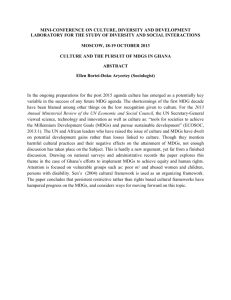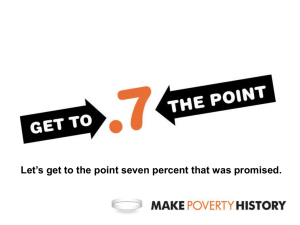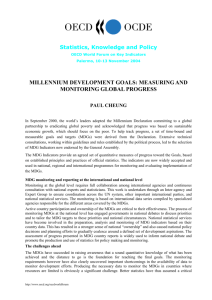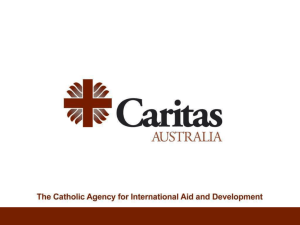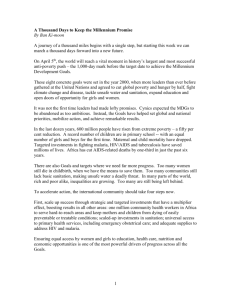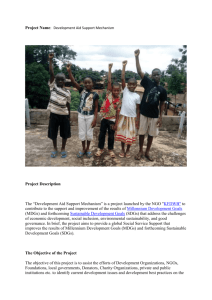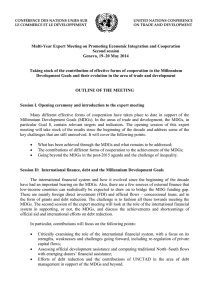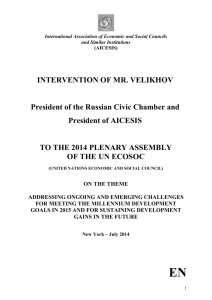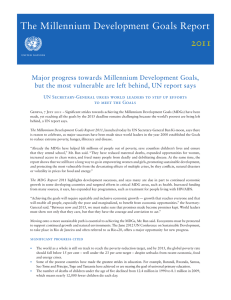Rescuing the MDGs: Paying for results NYU, New York September 15, 2005
advertisement
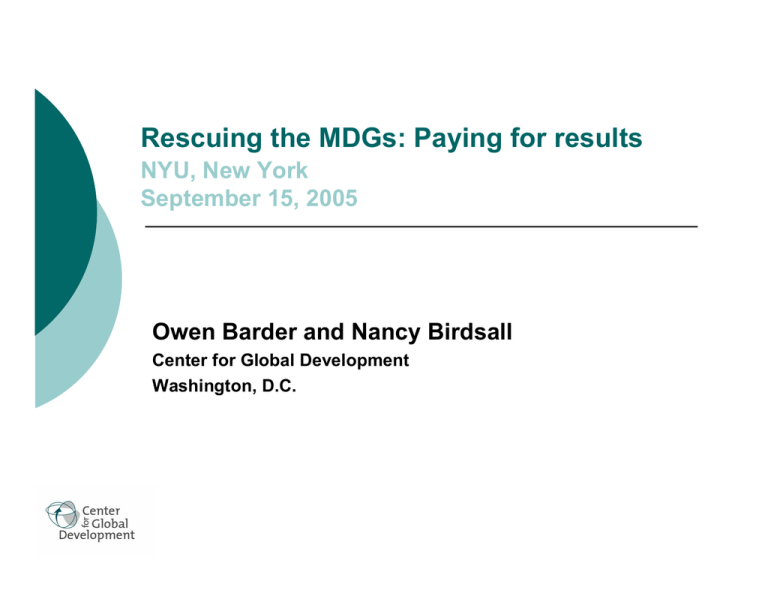
Rescuing the MDGs: Paying for results
NYU, New York
September 15, 2005
Owen Barder and Nancy Birdsall
Center for Global Development
Washington, D.C.
Outline
{
What’s wrong with the MDGs?
{
The current approach
{
Rescuing the MDGs: What about aid?
{
The proposal
{
Trans-Atlantic tension: A synthesis
What’s wrong with the MDGs?
o They are not realistic…
What’s wrong with the MDGs?
Source: Clemens and Moss (2005). “What’s Wrong with the Millennium Development Goals” at
http://www.cgdev.org/content/publications/detail/3940
What’s wrong with the MDGs?
{
They are not realistic
{
And they risk turning “real” success
into “imaginary” failure
What’s wrong with the MDGs?
Source: Clemens and Moss (2005).
The current approach
The current approach
{
Starts from needs (good)
{
Adds up “costs” (misleading)
The current approach
M DG cost estim ate for m eeting the M DG education goal 1
(per capita, constant 2003 US$)
Bangladesh
Cam bodia
G hana
Tanzania
Uganda
2006
2010
2015
2006
2010
2015
2006
2010
2015
2006
2010
2015
2006
2010
2015
Education 2
11
17
25
15
19
22
17
19
22
11
13
17
14
15
17
Prim ary education 3
13
15
17
8
10
12
7
8
12
Notes:
1. M DG investm ent needs are defined as the capital investm ents and operating expenditures required to m eet
a given MDG , excluding expenditures for capacity building.
2. Education estim ates include prim ary and secondary education.
3. The prim ary education cost estim ates are in constant 2000 US$ and the 2006 num bers refer to 2005 for this
indicator.
Source: UN Millennium Project (2005) Investing in Developm ent. A Practical Plan to Achieve the M illennium
Development G oals, Chapter 17 and UN Millennium Project (2004) "Millennium Developm ent G oals Needs
Assessm ents for G hana, Tanzania, and Uganda."
The current approach
{
But “cost” estimates ignore demand
constraints, complementarities, nonmarginal, non-constant returns…
{
And they suggest more spending is the
answer
{
Though there is no particular association
between spending and education outcomes
100
The current approach
United Kingdom
Panama
Belize
Bolivia
United States
Cambodia
Dominican Republic
TogoKazakhstan
Lebanon
Trinidad
and
Tobago
Costa
Rica
El Salvador
Mauritius
Kyrgyz RepublicCroatia South Africa Morocco
Georgia
Colombia
Macao, China
Chile
Bangladesh
LaoNicaragua
PDR
Ukraine
United Arab Emirates
80
90
Armenia
School enrollment, primary (% net)
Cape Verde
Azerbaijan
Gambia, The
Moldova
Namibia
Mongolia
Swaziland
70
Oman
2
4
6
Public spending on education, total (% of GDP)
Source: WDI (2005).
8
10
The current approach
. . . not in the developing world, and not in
New Jersey
{
Abbott v. Burke case
{
Equalize school funding: New Jersey
{
Equal since 1997
{
Transfer of $1,924 per student
{
$30 billion transferred, 1997-2004
Source: Clemens (2005) “International Tax.”
New Jersey 8th grade basic language
skills test: pass rate
100%
74%
75%
50%
80%
47%
41%
25%
0%
1996
Source: Clemens (2005) “International Tax.”
2004
Abbott districts
Rest of state
The current approach
Camden
African-American/Latino
97%
Avg. residence value
$24,400
Eligible for free lunch
78%
Crime rate per 1000
86
Unemployment
12%
Budget per student
$17,500
25%
8th grade proficiency test
Source: Clemens (2005) “International Tax.”
State
33%
$147,500
28%
32
4%
$12,000
80%
The current approach
{
“Cost estimates ignore demand
constraints, complementarities, nonmarginal, non-constant returns…
{
Suggest more spending is the answer…
{
And the need for more spending
implies foreign aid is the constraint
The current approach
As many studies seem to imply…
Study
Devarajan, et al "Goals for Development" (WB
2002)
Vandemoortele, "Are the MDGs feasible?" (UN
2002)
Covering
Global poverty goal
Global social and environ. goals
Global primary education
Global MDGs
Global poverty goal
Greenhill, "The Unbreakable link" (Jubilee
Research, 2002)
"Last Chance in Monterrey" (Oxfam 2002)
"Supporting Sound Policies…" (WB 2003)
"Achieving the MDGs in Africa…" (AfDB 2002)
Delamonica et al (Unicef, 2001)
"Education for Dynamic Economies…" (WB
2002)
Naschold, "Aid and the MDGs" (ODI 2002)
Filmer, “Costing the Goal…” (WB 2002)
Mingat, et al "Financing Education for all…" (WB
2002)
Brossard et al., “Education Primaire Universelle:
Combien?” (Unesco 2001)
Bruns et al, A Chance for Every Child (WB
2003)
Source: Clemens and Moss (2005)
Global, other goals
Additional resources /
year
$54-62 billion
$35-75 billion
$10-15 billion
$50-80 billion
$15-46 billion, + cancel
debt
$16.5 billion, + cancel
debt
$100 billion
double / triple aid
60% increase
$20-25 billion
$9.1 billion
$2.5-5 billion
Global MDGs
Asia and South Asia
Africa and Central Asia
Sample of 30 African countries
Global primary education
Primary education, 47 IDA
countries
African primary education
Global primary education
Global Primary education
Primary Education for 33 African
countries
African primary education
$2.9-3.4 billion
Low-income primary education
$5-7 billion
7x aid
$9 billion
$30 billion
$2.1 billion
Rescuing the MDGs: What about aid?
{
Aid cannot drive the process…but
constraints on resources should not be
a constraint on progress
{
Aid should create and enhance
incentives for households,
communities, and governments toward
the MDGs, and support good
institutions
Rescuing the MDGs…
(and the aid business from itself)
Rescuing the MDGs: What about aid?
{
But currently aid tends to make
recipient countries accountable to
donors, not their citizens
Aid and government revenue in selected countries 2003
Total net ODA
Burundi
Sierra Leone
Malawi
West Bank and Gaza
Mozambique
Ethiopia
Nicaragua
Mauritania
Rwanda
Mongolia
Niger
Tanzania
Uganda
Zambia
(% of GNI)
39
39
30
25
25
23
21
21
20
20
17
16
16
13
Total net ODA
per capita
(current US$)
31
56
45
289
55
22
152
85
40
100
39
47
38
54
Government revenue
excl. grants
(% of GDP)
21
12
18
14
20
21
14
38
10
11
12
18
Source: WDI (2005), ADB (2005) and IMF Regional Economic Outlook for Sub-Saharan Africa (2005).
The proposal
{
Recipient government defines countryspecific goals (not “universal MDGs)
{
Agrees with donor community on
country-specific benchmarks
{
Donors tie aid tied to progress against
those agreed benchmarks
{
Benchmarks can be inputs, outputs,
outcomes (all constitute “results”)
The proposal
{
Donors agree on a legally binding tariff,
e.g. $50 per year for every child in
school (above 1990 enrollment)
{
Cash amounts the same for all
countries
{
Annual independently audited “invoice”
presented by governments to donors
The proposal: An education example
{
MDG goal: all children complete primary
school by 2015
{
MP estimates of “cost” in poorest
countries of putting every child in
school
{
. . . provide a “weak” rationale for a
payment of $50 per child
(Back to education “costs”)
MDG cost estimate for meeting the MDG education goal1
(per capita, constant 2003 US$)
Bangladesh
Cambodia
Ghana
Tanzania
Uganda
2006
2010
2015
2006
2010
2015
2006
2010
2015
2006
2010
2015
2006
2010
2015
Education2
11
17
25
15
19
22
17
19
22
11
13
17
14
15
17
Primary education3
13
15
17
8
10
12
7
8
12
Notes:
1. MDG investment needs are defined as the capital investments and operating expenditures required to meet
a given MDG, excluding expenditures for capacity building.
2. Education estimates include primary and secondary education.
3. The primary education cost estimates are in constant 2000 US$ and the 2006 numbers refer to 2005 for this
indicator.
Source: UN Millennium Project (2005) Investing in Development. A Practical Plan to Achieve the Millennium
Development Goals, Chapter 17 and UN Millennium Project (2004) "Millennium Development Goals Needs
Assessments for Ghana, Tanzania, and Uganda."
The proposal
The process should create incentives for
households (enhance household demand),
support public “supply”, and make
government accountable to its own citizens.
{
Vouchers worth $50 go to poor households for
each child in school,
{
Are collected by schools, which
{
“sell” them to local government or other
official intermediary. . . and then to the
Finance Ministry, which bills donors
The proposal
Rough estimates of resulting annual donor transfers, selected countries
Primary education
Donor transfers at actual
primary enrollment 2001
Donor transfers for 1990-2001
increment in primary
enrollment
($50 per student)
($50 per student)
Donor transfers for 1990-2015
increment in primary
enrollment assuming universal
enrollment in 2015
($50 per student)
Bangladesh
870,000,000
255,000,000
500,000,000
Cambodia
85,000,000
33,000,000
58,000,000
Ghana
105,000,000
29,000,000
115,000,000
Tanzania
155,000,000
23,000,000
237,000,000
-
-
310,000,000
50,000,000
20,000,000
17,000,000
Uganda
Tajikistan
Sources: United Nations World Population Prospects: The 2004 Revision, World Bank EdStats (2005) and author's calculations.
The proposal
Benefits:
{
No arguments over “conditionality.” Payments
tied to results not policies
{
Binding donor commitments provide predictable,
long-term funding against which performing
governments can plan, invest…
{
and borrow on private markets
{
Makes recipient country governments
accountable since a shortfall in achievement
cannot be blamed on insufficient donor aid.
The proposal
“Changing
education systems
requires political
leadership and
institutional reform,
as well as additional
investments and
inputs”
Source: UN Millennium Project ,Taskforce on Education and
Gender, Toward Universal Primary Education: Investments,
Incentives and Institutions, p. 24.
Trans-Atlantic Tension: A synthesis
Two Views About Aid and the MDGs
“[T]he key question is how we can meet in practice the ambitious Millennium
Development Goals. If every child is to have primary education, we will need
$10 billion more a year. If infant mortality is to be cut by two thirds and
maternal mortality by three-quarters, we will need at least $15 billion extra a
year. If we are to halve poverty by 2015 we will need an additional $20 billion
or more each year.”
-Gordon Brown, 2003
“Aid is just one of many important inputs to development, and the amount of
aid that will be needed to meet the MDGs will depend critically on the quantity
and quality of the supply of these other inputs. Indeed, the argument for
targeting good performers grows out of the recognition that aid is most
effective when coupled with good governance, and sound policy. ... Moving
forward, we will need to present increased development assistance as a clear
means towards an end rather than as an end in itself. This will require us
(first) to define clear objectives for development funding and (then) to identify
demonstrable results associated with those objectives.”
-John Taylor, 2005
Trans-Atlantic Tension: A synthesis
{
There is a resource constraint in poor
recipient countries (per Gordon Brown)
Bangladesh
Burundi
Cambodia
Eritrea
Nepal
Niger
Sierra Leone
Health expenditure
per capita
(current US$)
2002
11
3
32
8
12
7
6
Source: WDI (2005) and author's calculations.
Primary education
expenditure per capita
(current US$)
2002
34
12
18
19
29
26
21
Trans-Atlantic Tension: A synthesis
{
But external resources should be linked
to results (per John Taylor)
{
And should create, not undermine
government accountability to citizens
Trans-Atlantic Tension: A synthesis
What the “cost” studies do really tell us:
{
The necessary “additional resources” are
feasible: well inside what donors have already
pledged
{
And, if all other conditions were adequate
(institutions, incentives), additional resources
would make a difference
{
The challenge: ensuring that new resources
complement rather than substitute for
incentives and institutions
Conclusion
Treat the MDGs seriously but not literally
